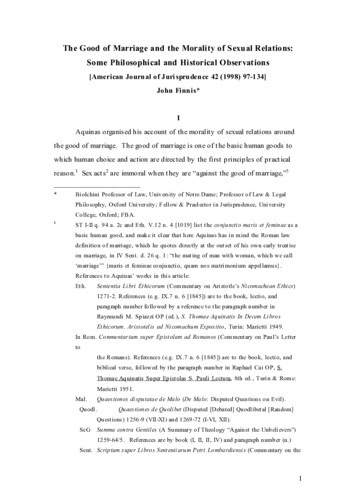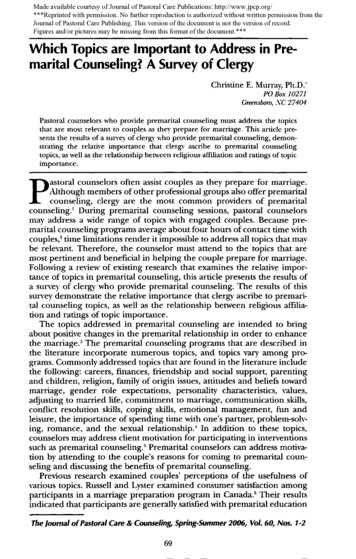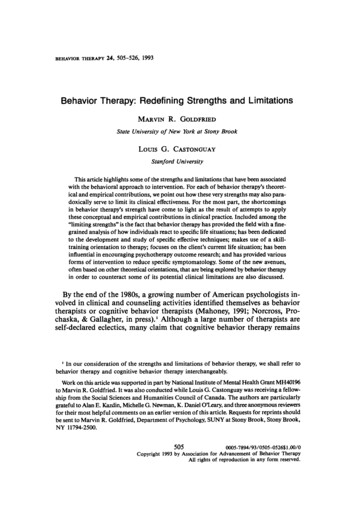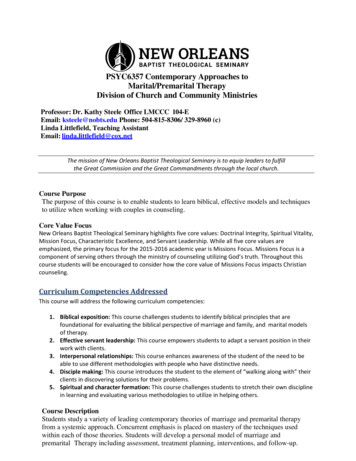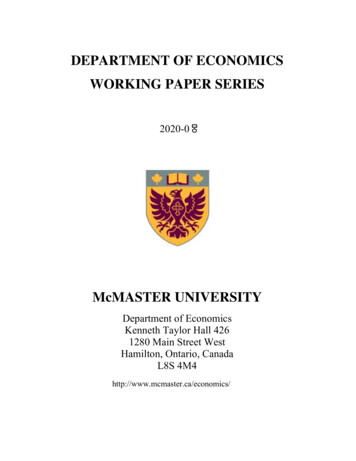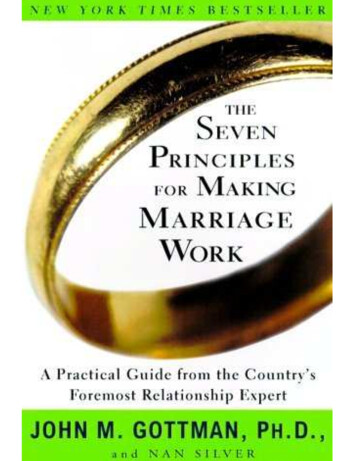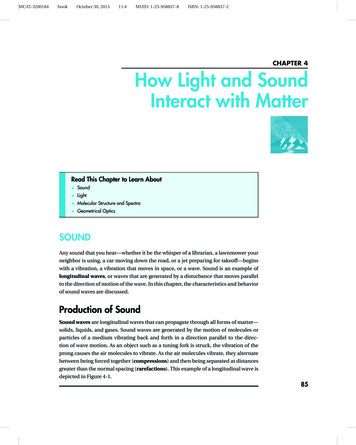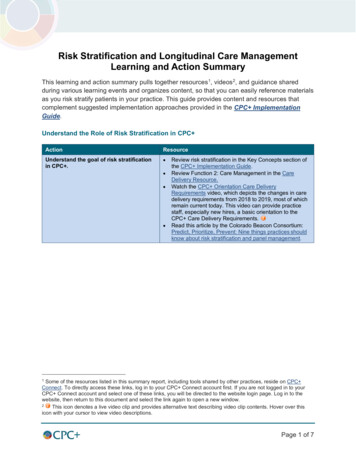
Transcription
Copyright 1995 by the American Psychological Association, Inc.0033-2909/95/S3.00Psychological Bulletin1995, Vol. 118, No. 1,3-34The Longitudinal Course of Marital Quality and Stability:A Review of Theory, Method, and ResearchBenjamin R. Karney and Thomas N. BradburyUniversity of California, Los AngelesAlthough much has been learned from cross-sectional research on marriage, an understanding ofhow marriages develop, succeed, and fail is best achieved with longitudinal data. In view of growinginterest in longitudinal research on marriage, the authors reviewed and evaluated the literature onhow the quality and stability of marriages change over time. First, prevailing theoretical perspectivesare examined for their ability to explain change in marital quality and stability. Second, the methodsand findings of 115 longitudinal studies—representing over 45,000 marriages—are summarized andevaluated, yielding specific suggestions for improving this research. Finally, a model is outlined thatintegrates the strengths of previous theories of marriage, accounts for established findings, and indicates new directions for research on how marriages change.For many people, marriage begins as a source of satisfactionand fulfillment but ends as a source of frustration and despair.How does an endeavor approached with so much optimism leadso frequently to disillusionment? How do marriages change?Addressing these questions is important because nearly all people marry in their lifetime (Bjorksten & Stewart, 1984), yetnearly two thirds of all first marriages are expected to end inseparation or divorce (Castro-Martin & Bumpass, 1989). Subsequent remarriages are common and are even more likely toend (Brody, Neubaum, & Forehand, 1988; Cherlin, 1992).Moreover, whereas satisfying marriages tend to buifer spousesfrom psychological distress and negative life events (e.g., Waltz,Badura, Pfaff, & Schott, 1988), marital distress and instabilityhave negative consequences for the physical and emotional wellbeing of spouses (Bloom, Asher, & White, 1978) and their children (Emery, 1982; Grych & Fincham, 1990) and are leadingreasons why people seek psychological counseling (Veroff,Kulka, & Douvan, 1981).1A basic premise of this article is that a thorough understanding of how marriages develop and change would be importantin its own right and would contribute to the prevention andtreatment of marital dysfunction (see Bradbury & Fincham,1990b). A second basic premise is that an understanding ofmarital development is best achieved with data collected in Ion-Preparation of this article was supported by a National Science Foundation Graduate Fellowship and by Grant MH48674 from the NationalInstitute of Mental Health.We thank Bonnie Burman, Catherine Cohan, Andrew Christensen,Joanne Davila, and Anne Peplau for their helpful comments on a draftof this article. We especially thank Robert Rosenthal for valuable adviceon meta-analysis.Correspondence concerning this article should be addressed to Benjamin R. Karney or Thomas N. Bradbury, Department of Psychology,University of California, 405 Hilgard Avenue, Los Angeles, California90024-1563. Electronic mail may be sent via Internet to ibmdbrk mvs.oac.ucla.edu (Benjamin R. Karney) or bradbury@psych.sscnet.ucla.edu (Thomas N. Bradbury).gitudinal research designs. The extensive literature on marriageis based primarily on cross-sectional data and, although it hasproven valuable in several respects, this work reveals little abouthow marriages may become more or less satisfying and more orless stable over time. The limitations of this research for understanding how marriages succeed and fail have been recognized,and the calls for longitudinal research on marriage have beennumerous (e.g., Belsky & Pensky, 1988; Bowerman, 1964;Glenn, 1990; Gottman, 1991; Hicks & Platt, 1970; Hollingsworth, 1939; Levinger, 1980; Locke, 1968; Markman & Floyd,1980; Raush, Barry, Hertel, & Swain, 1974).In response to these calls, longitudinal studies of marriage areappearing in the research literature at an increasing rate (seeBerscheid, 1994). However, when longitudinal studies are reported, it is common even for leading researchers to grossly underestimate the amount of previous research devoted to investigating change in marital quality and stability. Indeed, we believe that many would be surprised to learn that over 100longitudinal studies of marriage have been published to date.This lack of awareness no doubt owes to the fact that the research has been spread across many decades and disciplines,and that, to our knowledge, there is no single source that identifies, analyzes, and integrates this literature. Researchers therefore lack a common base of knowledge for interpreting theirstudies or for designing new studies, and as a result new dataare unlikely to accumulate to refute theory or inform clinicalinterventions.In view of the basic and applied value of a clearer accountof how marriages succeed and fail, the increasing amount oflongitudinal research on this topic, and the absence of a comprehensive analysis of this research, the purpose of this article1Throughout this article, the terms marital quality, marital satisfaction, marital adjustment, and marital distress are used interchangeablyto refer to spouses' evaluations of their marriage (see Fincham & Bradbury, 1987a). In contrast, the terms marital stability and marital instability are used to refer to the status of the marriage (i.e., whether it iscontinuing or the spouses have separated or divorced).
BENJAMIN R. KARNEY AND THOMAS N. BRADBURYis to review and evaluate the available literature and to offeran integrative framework to guide future research on how thequality and stability of marriages change over time. The articleis organized into four sections. First, theoretical perspectivesthat have influenced longitudinal research on marriage are examined for their ability to explain how marriages change. Second, the longitudinal research itself is reviewed, with regard toboth the methods that have been used and the findings that haveresulted. Third, a model is proposed that integrates thestrengths of current theories of marriage, accounts for replicated findings, and suggests specific directions for future longitudinal research on marriage. A concluding section identifiesimmediate research priorities and explores the broader implications of this review.2Review of Theoretical Perspectives on MarriageFour theoretical perspectives that have influenced research onmarriage are reviewed in this section to provide a backgroundfor interpreting the large body of longitudinal data and to assistin developing an integrative framework that might inform subsequent research on marital development. Although an analysisof theory is important in any area, the need is particularly acutein the study of marriage because, as we conclude later in thearticle, much of the longitudinal work has not been explicitlytheoretical in orientation and because subsequent progress inunderstanding how marriages change is likely to depend heavilyon the quality of the available models. The four major theoretical perspectives that have influenced marital research to dateare evaluated in terms of three criteria.First, the theory should encompass a full range of possiblepredictors of marital outcome and should provide links betweendifferent levels of analysis (Furman, 1984;Kellam, 1986; Newcomb & Bentler, 1981; Raush, Greif, & Nugent, 1979; S. W.White & Mika, 1983). In the search for predictors of maritaloutcome, researchers have examined such macro-level variables as cultural norms as well as such micro-level variables asthe number of negative statements spouses make in an interaction. However, Riskin and Faunce (1972) pointed out that "noticeably lacking . . . are the intermediate level concepts andsteps through which to relate the low-order observational dataand variables to high-order abstractions" (p. 400). Many researchers have since echoed this sentiment (e.g., Furman, 1984;Newcomb & Bentler, 1981; Teachman, Polonko, & Scanzoni,1987). Influential theories of marriage therefore are evaluatedin terms of whether they acknowledge the full range of possibleinfluences on couples and whether they suggest how variables atdifferent levels of analysis affect each other.Second, the theory should specify mechanisms of changewithin marriage (Duck & Sants, 1983; Furman, 1984; Gale &Vetere, 1987; Glenn, 1990; O'Leary & Smith, 1991; Rutter,1981). Theorists have argued that a defining feature of any closerelationship is that it evolves over time. A major task of a theoryof marriage is to describe how development and change comeabout. Including this criterion emphasizes the importance ofexplaining how marriages achieve different outcomes, a goalthat is related to but likely to be more difficult than the actuarialtask of predicting which marriages will succeed or fail.Third, the theory should account for variability in maritaloutcomes between couples and within couples over time (Baltes,Reese, & Lipsitt, 1980; Belsky & Rovine, 1990; Glenn, 1990;Wamboldt & Reiss, 1989). A complete theory of marriagewould explain more than simply why couples divorce. A fullunderstanding of marriage would account for the range of possible marital outcomes, including divorce at different maritaldurations, marriages that persist despite dissatisfaction, marriages that decline in quality and then improve, and marriagesthat endure stably. A theory should explain how different couples or individuals reach different outcomes and why differentcouples or individuals may obtain different outcomes at different times over the course of a marriage.Although the theories reviewed below have influenced muchof the longitudinal research on marriage, they were not alwaysoffered with the goal of explaining marital change per se; it istherefore possible that no one perspective meets all three ofthese criteria. Nevertheless, examining theoretical perspectiveson marriage in terms of the standards that such a theory mustmeet is useful for identifying what each theory might contributeto a model of marital development. At the outset, we emphasizethat our review is necessarily brief; detailed discussions of thetheories are cited where appropriate.Social Exchange TheoryOverview. Social exchange theory, the most cited theoreticalperspective in research on marriage and close relationships,draws from Thibaut and Kelley's (1959) theory of interdependence and asserts that "relationships grow, develop, deteriorate,and dissolve as a consequence of an unfolding social-exchangeprocess, which may be conceived as a bartering of rewards andcosts both between the partners and between members of thepartnership and others" (Huston & Burgess, 1979, p. 4). Levinger (1965, 1976) was among the first to apply the concepts ofsocial exchange to marriage. He argued that marital success orfailure depends on an individual's weighing of the attractions ofthe relationship, or all the aspects of the relationship that maybe rewarding (e.g., emotional security, sexual fulfillment, andsocial status), the barriers to leaving the relationship (e.g., social and religious constraints and financial expenses), and thepresence of attractive alternatives outside the relationship (e.g.,preferable partners and escape from the current relationship).According to this perspective, marriages end when the attractions of the relationship are few, the barriers to leaving the rela2Detailed consideration of three well-developed subfields of maritalresearch has been excluded from our discussion. Specifically, treatmentoutcome studies are omitted because the present concern is with marriages as they develop and change naturally, rather than as a result ofclinical intervention (see Hahlweg, Baucom, & Markman, 1988; Shadish et al., 1993). Research on the transition to parenthood is omittedfrom the summary of studies because this is a well-developed literaturein its own right, and thorough reviews of this research are available (seeBelsky & Pensky, 1988; Michaels & Goldberg, 1988). Because this topicis directly relevant to understanding the course of marriage, however, itis discussed in the integrative section of the article. Finally, research onremarriage is omitted from the review of studies (see Spanier & Furstenberg, 1987), but because remarried and first-married couples oftenhave been examined together, results involving data from remarriedcouples are necessarily included.
LONGITUDINAL RESEARCH ON MARRIAGEtionship are weak, and the alternatives to the relationship areenticing.Using these ideas, Lewis and Spanier (1979, 1982) formedan exchange typology of marital relationships in which maritalsatisfaction and marital stability are conceived as orthogonaldimensions of marital outcome. Marriages can be satisfied andstable, satisfied but unstable, unsatisfied but stable, or unsatisfied and unstable; social exchange concepts explain couples'placement within specific quadrants. For example, unsatisfiedstable couples are those for whom the attractions within the relationship may be low, but the barriers to leaving the relationship are prohibitively high. Satisfied-unstable relationships arethose for whom attractions within the relationship may be adequate, but barriers to leaving the relationship are low and alternatives outside the relationship are even more attractive.Critique. A strength of social exchange theory, and a majorsource of its popularity, is that many types of variables can beincorporated into its framework. For example, within the concept of attractions, Levinger (1976) placed micro-level variables such as perceptions of companionship as well as sociodemographic variables such as occupational status. Barriers werealso conceived broadly and included macro-level variables suchas community norms against divorce as well as more specificwithin-spouse feelings of obligation. For most sets of variables,social exchange suggests how those variables may combine toinfluence marital outcomes. A second strength of social exchange is that, by clearly distinguishing marital satisfactionfrom marital stability, the theory potentially can account for avariety of marital outcomes. Lewis and Spanier's (1979, 1982)typology addresses varieties of success and failure in marriage,in that it allows for unhappy couples who remain together andfor relatively happy marriages that nevertheless dissolve.On the other hand, Lewis and Spanier's (1979, 1982) typology also reveals an important weakness of the social exchangeperspective. Whereas it acknowledges that "the quality and stability of a relationship may vary over the life cycle" (Lewis &Spanier, 1979, p. 286), social exchange theory does not addresshow change in marriage comes about. Social exchange describesmarriages that should be stable or unstable, but it does not speculate about how an initially stable marriage might become unstable over time. A temporal perspective is also lacking fromconceptualizations of attractions and barriers. Although thetheory links concurrent perceptions of attractions and alternatives to marital satisfaction and stability at a given moment, itdoes not explain where these perceptions originate or how theydevelop. Instead, this view maintains that "when persons aredissatisfied with their relationship they are apt to view it as inequitable; and. . . when they are satisfied they are likely to seeit as both equitable and equal" (Huston & Burgess, 1979, p.12). Thus, the variables that serve as attractions and barriersfor a given couple are likely to change as spouses' evaluations ofthe relationship change. One must look outside the theory tounderstand what constitutes attractions and barriers at differentpoints in the course of a marriage.Summary. Levinger (1976) called his original formulationof exchange theory a "perspective on marital dissolution" (p.21). Within that scope, social exchange is a useful tool, explaining how two couples who are equally dissatisfied with their marriages might have different thresholds for divorce. However, inits current form, the theory does not address the question ofhow couples reach the brink of dissolution, nor does it explainhow couples who enter marriage satisfied with the attractionswithin the relationship become more or less satisfied with thoseattractions over time.Behavioral TheoryOverview. Behavioral theories of marriage, like social exchange, have their roots in the work of Thibaut and Kelley(1959). The focus of social exchange theory, however, is primarily intrapersonal. Marital satisfaction is understood to bethe result of each individual's weighing of attractions and alternatives, and those attractions and alternatives are conceivedto be "aspects of perception, not action" (Gottman, 1982, p.950; see also Newcomb & Bentler, 1981). Although rewards andcosts are also basic elements of behavioral conceptions of marriage, instead the focus is on the interpersonal exchange of specific behaviors. Research in this tradition has concentrated onbehaviors exchanged during problem-solving discussions andhas been guided by the premise that rewarding or positive behaviors enhance global evaluations of the marriage while punishing or negative behaviors do harm (e.g., Markman, 1981;Stuart, 1969; Wills, Weiss, & Patterson, 1974). This basicframework has been expanded to include the attributions thatspouses make for partner behaviors (e.g., Baucom, 1987; Bradbury & Fincham, 1990a; Weiss, 1984). Unlike social exchangetheory, however, which focuses on these perceptions as directdeterminants of marital outcome, the behavioral model suggests that cognitive responses affect marriage through their influence on subsequent interaction behaviors. Over time, the accumulation of experiences during and after interaction arethought to gradually influence spouses' judgments of maritalquality (Bradbury & Fincham, 1991; Gottman, 1990,1993b).Critique. A strength of this approach is that it suggests amechanism to explain how judgments of marital satisfactionchange over time. Specifically, "spouses learn on the basis oftheir interactions and the appraisals that follow from themwhether or not they are in a rewarding relationship" (Bradbury& Fincham, 1991,p.l34). For satisfied couples, each satisfyinginteraction justifies continued satisfaction, which in turn makesfurther satisfying interaction more likely. Marital distress, onthe other hand, may be largely a consequence of a couple'sdifficulty dealing with conflict. As Markman (1991) noted, "tothe extent that normal marital disagreements are not handledwell, unresolved negative feelings start to build up, fueling destructive patterns of marital interaction and eventually erodingand attacking the positive aspects of the relationship" (p. 422).A more detailed discussion of the formation of these patternsis offered by coercion theory (Patterson & Reid, 1970), whichdescribes how spouses reward and shape each other's negativebehaviors inadvertently. If repeated nagging from one spouseultimately results in a desired behavior from the other spouse,for example, the nagging is reinforced and is likely to recur.Gottman and Levenson's (1986; Gottman, 1993b) escape conditioning model makes the similar prediction that behaviorsleading to decline in both spouses' level of emotional arousalwill be negatively reinforced. To the extent that aversive behav iors, such as expressing anger or contempt, are followed by de-
BENJAMIN R. KARNEY AND THOMAS N. BRADBURYclines in arousal, these behaviors will increase in frequency anddestructive patterns of behavior may become entrenched. Eachof these mechanisms describes marriage as a dynamic phenomenon, characterized by an ongoing feedback from the interaction between spouses to the sentiments of each spouse about themarriage and back again. In this respect, behavioral theory hasa perspective on change in marriage that appears to be lackingin social exchange theory.However, the strong focus on interaction also can be viewed asa weakness of this model. Marital interaction, to be understoodfully, probably needs to be examined within the broader contextof spouses' lives (Davis, 1982; Raush et al., 1979; Smith, Vivian, & O'Leary, 1990). Within the behavioral tradition, microlevel analyses of interaction have been emphasized at theexpense of considering the circumstances in which interactionoccurs. The sources of marital interaction patterns, and thevariables that affect day-to-day variation in these patterns, havebeen outside the scope of behavioral models of marriage. As aresult, there have been few attempts to link macro-level variables—such as personality, education, or life events—to behavior exchange, despite the strong possibility that these variablesaffect marital interaction.A second weakness of behavioral theory is that it explainsonly a limited range of marital outcomes. For example, behavioral models explain within-couple variation in marital satisfaction but only in one direction. Coercion theory and the escape conditioning model suggest how negative behaviors mightdevelop into entrenched destructive patterns, but they do notexplain how initially adaptive communication patterns mightdeteriorate over time or how couples lacking adequate skillsmight improve spontaneously. Also unaddressed is the questionof when distress leads to divorce. The presence of harmful interaction patterns characterizes some couples that divorce aftera few years of marriage and others that remain married despiteyears of conflict. Behavioral theory alone does not account forvariation in marital duration.Summary. Behavioral models make unique contributionsto an understanding of marital development. They offer aframework for investigating the behaviors that spouses exchange, and they suggest plausible and concrete mechanismsfor change in judgments of marital quality. On the other hand,perhaps as a result of this detailed focus on interaction, theseideas have not yet been incorporated into a broader developmental perspective on marriage.Attachment TheoryOverview. Attachment theories of marriage draw fromwork by Bowlby (1969) on relationships between infants andtheir primary caregivers. Bowlby suggested that the nature ofthis first close relationship determines a child's internal workingmodel of what close relationships are like, so it should determine the nature of an individual's close relationships throughout the life course. Although in theory the variety of possibleinfant-caregiver bonds is infinite, in practice researchers haveemphasized three major styles of early attachment (Ainsworth,Blehar, Waters, & Wall, 1978). Secure attachment, the stylemost commonly observed between mothers and infants, isthought to be the ideal and describes parents who are availablefor their children and children for whom the attachment to thecaregiver provides a base for exploration of novel stimuli.Anxious /ambivalent attachment describes parents who are inconsistently responsive to their infants, resulting in infants whosimultaneously crave and resent the caregiver. Anxious/avoidant attachment describes parents who are not responsiveto their infants and infants who, therefore, avoid contact withthe caregiver and are not distressed by separations.Kazan and Shaver (1987, 1994; Shaver, Kazan, & Bradshaw,1988) applied these ideas to adult relationships directly, arguingthat close relationships between adults reflect enduring styles ofattachment developed in infancy and early childhood, and thatthe attachment styles described by Ainsworth et al. (1978) accurately describe styles of adult attachment as well. This perspective emphasizes that individuals' early experiences in closerelationships shape the nature and development of subsequentrelationships in adulthood. Relationship satisfaction, therefore,"depends largely on the satisfaction of basic needs for comfort,care, and sexual gratification" (Kazan & Shaver, 1994, p. 13)and the success of a given relationship will rest on whether eachspouse trusts that the partner can fulfill those needs.Critique. According to attachment theory, marital successor failure will be affected by enduring aspects of each partner'srelationship history and family of origin. A strength of this approach is that it suggests links between levels of analysis that areunderemphasized in or absent from exchange and behavioraltheories. In its focus on continuity over the life span, however,attachment theory often overlooks sources of change and variability in marriage. For example, attachment theory draws attention to the importance of personal history in determiningthe relationship needs of each partner, but it does not describehow personal histories affect the development of a marriageonce two people with different relationship needs come together.Although the theory suggests that "the relative importance ofvarious needs changes over time" (Kazan & Shaver, 1994, p.14), the sources of change in relationship needs and how thischange comes about remain to be specified. Similarly, the theory maintains that marriages remain satisfying to the extentthat partners are able to meet each other's new needs as theyarise, but it does not address the possibility that spouses' abilities to meet each other's needs may change over time, even whenthe needs themselves remain stable. In other words, attachmenttheory does not explain how individual differences in personalhistory affect the development of a marriage from beginningto end.Attachment theory also has not addressed sources of variation between couples. Whereas the theory asserts that individuals with secure attachment styles should have longer relationships, it also maintains that under certain circumstances individuals with anxious/ambivalent or anxious/avoidant styles canhave enduring relationships as well. The variables that influencemarital success or failure for such individuals, however, awaitspecification, as do the sources of variability in marital outcomebetween couples that share the same attachment style. Finally,the theory does not explain when in the course of a marriageunmet attachment needs lead to divorce.Summary. Attachment theory draws attention to the roleof personal history in marriage, a variable overlooked by socialexchange and behavioral theories. On the other hand, whereas
LONGITUDINAL RESEARCH ON MARRIAGEattachment theory could be called developmental in the sensethat it suggests links between childhood experience and adultrelationships, it does not provide a developmental view of themarriage itself. Attachment theory alone does not explain howcouples change over time or why some couples develop differently from others.Crisis TheoryOverview. Crisis theory derives from Hill's (1949) efforts toexplain how families react to stressful events. Why do somefamilies rise to face challenges and adverse situations whereasothers appear to give up or deteriorate? According to Hill'sABCX model, stressful events (A) require some adaptationfrom a family. Families have varying levels of concrete resources(B) and may arrive at different definitions of events (C) thatmodify the impact of those events. In any given circumstance,the extent to which available resources are sufficient to meetthe requirements implied by a family's definition of an eventdetermines the nature of the crisis (X) and whether a familywill recover successfully. Successful recovery involves adaptation that "preserves family unity and enhances the family system and member growth and development" (McCubbin & Patterson, 1982, p. 45).McCubbin and Patterson (1982), noting that Hill's (1949)original model focused only on variables that exist before a crisis occurs, added a temporal perspective to crisis theory. Theyexpanded the basic model in two ways. First, they acknowledgedthat responses to an event can develop over time. Second, theyacknowledged that responses to an event may have implicationsfor responses to future events. In their resulting double ABCXmodel, each element of Hill's original model is thought to haveits initial meaning and a meaning that emerges over time. Forexample, the initial efforts to cope with an event (A) can createadded stressors, a process McCubbin and Patterson called pileup. An initial level of resources (B) can be enhanced in response to an event. In addition to the initial perception of theevent (C), perceptions of the subsequent coping should alsoaffect eventual outcomes. Finally, a response to a crisis (X) canresult in both adaptation and maladaptation.Although crisis theory was designed to explain the functioning of families, some marital researchers have used the theoryto explain and predict marital outcomes. These efforts assumethat declines in marital satisfaction and the occurrence of separation or divorce reflect failures to recover from crises. In general, couples experiencing more stressful events should be morevulnerable to negative marital outcomes, and this effect shouldbe moderated by the couple's levels of resources and the couple's definitions of events.Critique. Crisis theory expands the scope of thinking aboutmarriage in important ways. For instance, in the perspectivesdiscussed previously, marriages are thought to be influencedprimarily by variables originating either within or between thespouses. When variables outside the relationship have been addressed, as in the alternatives described by social exchange theorists, they are described primarily as operating on eachspouse's perceptions of the relationship. In contrast, crisis theory is the first perspective to focus on the direct effects of external events on processes within spouses (definitions of the event)and between spouses (adaptation). .Thus, in crisis theory, married couples are placed in an ongoing interaction with their external world.Crisis theory also addresses aspects of marital outcome forwhich other theories do not account. As with the theories already discuss
how marriages develop, succeed, and fail is best achieved with longitudinal data. In view of growing interest in longitudinal research on marriage, the authors reviewed and evaluated the literature on how the quality and stability of marriages cha

